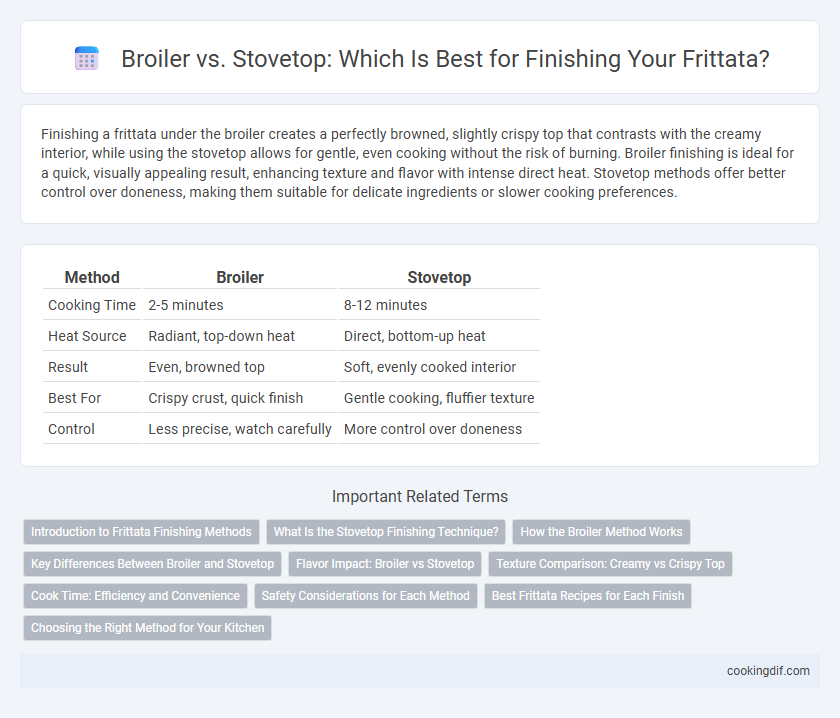Finishing a frittata under the broiler creates a perfectly browned, slightly crispy top that contrasts with the creamy interior, while using the stovetop allows for gentle, even cooking without the risk of burning. Broiler finishing is ideal for a quick, visually appealing result, enhancing texture and flavor with intense direct heat. Stovetop methods offer better control over doneness, making them suitable for delicate ingredients or slower cooking preferences.
Table of Comparison
| Method | Broiler | Stovetop |
|---|---|---|
| Cooking Time | 2-5 minutes | 8-12 minutes |
| Heat Source | Radiant, top-down heat | Direct, bottom-up heat |
| Result | Even, browned top | Soft, evenly cooked interior |
| Best For | Crispy crust, quick finish | Gentle cooking, fluffier texture |
| Control | Less precise, watch carefully | More control over doneness |
Introduction to Frittata Finishing Methods
Broiler finishing for frittatas creates a golden, bubbly top layer through intense, direct heat, providing a crisp texture and appealing visual contrast. Stovetop finishing relies on gentle heat to cook the frittata evenly from the bottom up, resulting in a tender, uniformly set dish without browning. Choosing between broiler and stovetop methods depends on desired texture and appearance, with broiler offering a quicker, more dramatic finish.
What Is the Stovetop Finishing Technique?
The stovetop finishing technique for frittata involves cooking the mixture over low heat on the burner after initial sauteing, allowing the eggs to set gently without browning too quickly. This method ensures a creamy, evenly cooked interior with a tender texture by controlling temperature and stirring occasionally if needed. Compared to broiler finishing, it reduces the risk of overcooking the top while delivering consistent, soft results throughout the dish.
How the Broiler Method Works
The broiler method for finishing a frittata involves placing the pan under intense direct heat from above, creating a golden, bubbly top without overcooking the interior. This technique uses radiant heat to quickly brown and set the eggs, producing a crispy, flavorful crust. By carefully monitoring the frittata under the broiler for 2-4 minutes, you achieve a perfectly finished dish with a contrasting texture between the creamy middle and crisp surface.
Key Differences Between Broiler and Stovetop
Broiler finishing exposes the frittata to intense, direct heat from above, creating a browned, crisp top layer within minutes, while stovetop finishing uses gentle, even heat to cook the frittata through without browning. Broiler cooks faster but requires careful monitoring to prevent burning, whereas stovetop provides more controlled, consistent cooking ideal for thick or delicate frittatas. The choice of method impacts texture, browning, and overall flavor development in the final dish.
Flavor Impact: Broiler vs Stovetop
Finishing a frittata under the broiler imparts a golden, slightly charred crust that intensifies flavor through caramelization and Maillard reactions, enhancing depth and complexity. Stovetop finishing produces a more evenly cooked, tender surface with milder, creamier notes that preserve the egg's delicate texture. Flavor intensity and texture contrast vary significantly between broiler's high-heat crispiness and stovetop's gentle, uniform cooking approach.
Texture Comparison: Creamy vs Crispy Top
Broiler finishing on a frittata creates a crispy, golden top layer while maintaining a creamy interior, offering a satisfying contrast in texture. Stovetop finishing tends to yield a uniformly soft and creamy texture throughout, lacking the crunchy surface achieved under the broiler. For those seeking a balance of crispness and creaminess, broiler finishing provides a superior texture experience in frittata preparation.
Cook Time: Efficiency and Convenience
Broiler finishing reduces cook time significantly, often crisping the frittata's top in just 2-5 minutes, enhancing efficiency in busy kitchens. Stovetop finishing may require 7-10 minutes with careful monitoring to ensure even cooking without burning. Choosing broiler finishing maximizes convenience by providing a quick, hands-off method, while stovetop allows for gradual control but demands more attention.
Safety Considerations for Each Method
Broiler finishing for frittatas requires careful monitoring to prevent burning and ensure even cooking, as the intense heat can quickly char surfaces while leaving the inside undercooked. Stovetop finishing offers more controlled heat application, reducing the risk of overheating or fire hazards, and allows safer gradual cooking especially when using non-stick pans. Proper use of oven mitts and heat-resistant tools is essential with broiler methods, while stovetop methods demand attention to open flames and burner safety to prevent accidents.
Best Frittata Recipes for Each Finish
Broiler finishing provides a quick, intense heat that crisps the top of the frittata, ideal for recipes featuring softer ingredients like spinach, cheese, or mushrooms, resulting in a golden, bubbly crust. Stovetop finishing offers gentle, even cooking, perfect for heartier frittatas with dense vegetables or meats, ensuring thorough cooking without over-browning. Selecting the broiler for delicate textures or the stovetop for robust fillings maximizes flavor and presentation in the best frittata recipes.
Choosing the Right Method for Your Kitchen
Choosing between broiler and stovetop methods for finishing a frittata depends on your kitchen setup and desired texture. Broilers provide a quick, even browning on top, ideal for achieving a golden crust without overcooking the interior. Stovetop finishing offers more control over heat distribution, allowing for a tender, evenly cooked frittata when a broiler is unavailable or for those preferring a softer top.
Broiler vs Stovetop for frittata finishing Infographic

 cookingdif.com
cookingdif.com